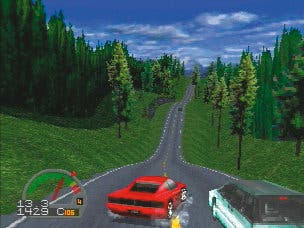Retrospective: The Need for Speed
Back to where it all began on the 3DO.
Let me tell you why my driving to Sawbridgeworth in the summer of 1994 was one of the best decisions of my gaming life. It's not without relevance, I assure you.
Before I do, however, a little context is necessary. During my early teenage years, I suffered from something of an inferiority complex. I had a Spectrum when mates had C64s, a Master System during the NES dominance, an ST when everyone drooled over the Amiga, and a Mega Drive just as... actually, I ended up owning a SNES as well so that generation worked out without trauma. (And with hindsight - and a dollop of maturity thrown in - I've since been able to properly appreciate the numerous remarkable titles those systems played host to and that I thankfully didn't miss out on.)
Nevertheless, when the 3DO turned up I scrambled the required 400 notes together (to this day I don't know how), keen to place myself at the forefront of gaming's 'next generation'. In your face, Philips CD-i.
Okay, a year later I'd boarded the PlayStation train, but until that point I was one of the 20 or so people in the UK who owned a 3DO. Far from regretting it, I relish the short time I spent in the company of my Panasonic-produced console, because it gave me the opportunity to enjoy one of the greatest driving game experiences of all time.

I had The Need for Speed on my will-donate-my-feet-for-the-advancement-of-podiatry-to-get-this list from the moment it was announced in magazines. I was aware that developer EA Canada was effectively an evolution of Distinctive Software, whose dry-yet-oddly-engrossing Test Drive games I'd previously experienced on the ST. From the descriptions and screenshots, EA's forthcoming driving effort looked like a supercharged Test Drive - the mechanics of a PC-like sim wrapped in the visual sensibilities expected of 'next-gen' console titles.
On paper, then, pretty much my dream creation. The wait for its arrival was therefore tortuous. My fellow few 3DO owners will no doubt remember that you could rely on 3DO game release dates as much as you can expect EasyJet to keep to its flight times these days.
Which is why, having phoned every games shop within a 30-mile radius, I jumped in the car and raced towards Sawbridgeworth, home of Special Reserve and the only retailer to confirm it had stock in. And sure enough, three copies sat on a shelf unloved, cruelly ignored by the other punters. Fools, I figured, before handing over the cash and returning home to spend the rest of the summer - as with the autumn and winter, it turned out - in a bit of a Need for Speed blur.

Break the game down into its components and it may be difficult to spot the brilliance: one-on-one racing from a selection of eight sports cars, three point-to-point tracks, each subdivided into three stages, a sprinkling of civilian traffic and the odd traffic cop to outrun. Pretty tame even back then, perhaps, but what that list doesn't convey are the elements that held everything together.
Developed with input from Road & Track magazine, The Need for Speed was desperate to showcase the gloriousness of its vehicles - Dodge Viper RT/10, Acura NSX, Mazda RX-7, Toyota Supra Turbo, Lamborghini Diablo VT, Porsche 911 Carrera, Chevrolet Corvette ZR-1, Ferrari 512TR - at a time Kazunori Yamauchi was still toying around with cartoon cars. In 1994 and the era of the CD, this effectively meant FMV sequences. The game features plenty of stat screens, but the videos are given prominence, both in between stages (this is how your frankly annoying opponent 'communicates') and as short clips featuring the kind of stylish cinematography Top Gear hadn't thought of yet.

